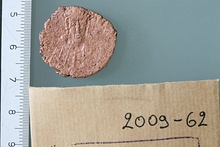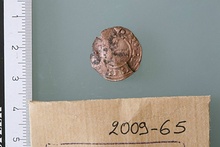| Collection: | Corinth | |
| Type: | Basket | |
| Name: | Nezi Field, context 496 | |
| Area: | Nezi Field | |
| Context Type: | Robbing trench | |
| Title: | robbing trench fill | |
| Category: | Deposit | |
| Notebook: | 1103 | |
| Context: | 496 | |
| Page: | 0 | |
| Date: | 2009/04/30 | |
| Stratum: | 35% angular and subangular pebbles, some large cobbles, tiles | |
| Description: | Top slope of the context is level. The soil color is dark yellowish brown. The soil compaction is compacted. The soil is poorly sorted. It is sandy silt. | |
| Notes: | This is the excavation of the fill from the robbing trench for walls 366 and 306. We investogated the area (cleaning context 482) and it appears that we have one L-shaped robbing trench for walls 306 and 366. It is possible that there are two different robbing trenches but at this point they are not distinguishable. We will begin the excavation of the fill from wall 306 and unless we identify a soil change we will proceed with the excavation of the fill from wall 366 to the east. The identification of this robbing trench was not easy. Its boundaries were clear on the north (for wall 366) but more diffuse on the south (for wall 306) and west (for wall 306). The fact that the western part of wall 366 and northern part of wall 306 are missing indicates that the walls were robbed out. In the process of excavation Kostas noted that there is no cut that would indicate that the two walls were robbed out with two different trenches. He also notes that the soil becomes looser as we go deeper. We completed the excavation of the robbing trench fill to the north of wall 306. Just north of the visible remains of wall 306 we uncovered part of the foundation of the wall continuing to the north before it disappears because of the robbing. At the southern part of the robbing trench, the trench is not much wider than the wall; only 10-15 cm on either side. It is possible that part of the foundation trench is preserved on the east side. We know, because of the elevation of the cut, that the wall was visible when it was robbed out. There was no need to dig down to find the wall but they could pull out the stones. It should be noted however that the robbing trench becomes wider at its northwestern end. Also at the southern end of the robbing trench, at the bottom where the foundation of the wall is visible, we exposed a more compacted surface. It seems that the stones of the foundation are resting on this surface. This compacted surface is cut by what we think is an earlier pit; we are still uncertain about the surface of the pit. We also observed a difference on the walls of the robbing trench. Approximately in the center of both sides there is a concentration of tiles; they might be the result of a pit or of a different activity. In any case they are earlier than the construction of wall 306. As mentioned above we believe that we have an L-shaped robbing trench. We are now digging west of wall 366. On the western side of the robbing trench, where it meets the trench for wall 306, the cut is not clear. We could not identify the cut at the intersection. On the surface the cut is visible on the north side. On the south side there is only a slight change in soil color. It should also be noted that the fill west of wall 366 is more compacted than the soil to the north. May 4th 2009: We finished this morning the excavation of context 496 which is the robbing trech fill for walls 306 and 366. this morning we finished the excavation of th eastern part of the context, which continues along the orientation of of wall 366. The excavation revealed additional stones of wall 366 in the bottom of the trench that were not robbed out. Toward the west, at the corner of the robbing trench, where walls 366 and 306 would have met, the circular continuation of the pit cut identified in the bottom of the trench for the robbing of wall 306 was discerned. Also noted was a change in soil color at the east part of the base of the robbing trench where reddish soil was revealed and potentially bedrock or a block cut from bedrock. The pit fill uncovered at the bottom of the robbing trench appears to be earlier than the construction of the walls 306 and 366. However, we are still unsure about the top elevation of the cut of the pit and wether the various deposits visible in the section of the walls of the robbing trench are assocated with the pit or not. We closed this context. | |
| Context Pottery: | Fineware. 12th c. - 27; Fineware. glaze painted IV, slipped (1220-1260), bowl. 1 rim. 1 bodysherd. ; Fineware. grid iron protomaiolica, bowl. 1 rim. ; Fineware. ww polychrome (1050-1120), pitcher. 2 handles. ; Fineware. classica - 37; Fineware. 11th c. - 28; Fineware. late sgraffito, slipped style VII (1250-1300), plate. 1 bodysherd. ; Fineware. roman - 10 | |
| Pottery Summary: | 112 frag(s) 0.44 kg. (0% saved) fineware. | |
| 1458 frag(s) 14.52 kg. (0% saved) coarseware. | ||
| 351 frag(s) 2.64 kg. (0% saved) cooking ware. | ||
| Context Artifacts: | glass clear, bs 2, green bs 2, thickened rim 1,conical beaker rim 1 as Jalame 453, yellow bs 1, colorless bs 2, bluish bs 2, thickened rim 1, borwn bs 1,; shell murex , cockelle 2; iron nail 2, crucible 2, shank 1, chain link 1, lump 1, boot heel cleat as 2001-30a; bronze belt buckle 1; glass waster 1; wall plaster red 1; marble revetment porphyri 1; lamp 1; Bone- coracoid of Aves, lg (Bird - Large) - 1 example(s).; Bone- cranial of Capra aegagrus hircus (Sheep/Goat) - 1 example(s).; Bone- femur of Aves, md (Bird - Medium) - 1 example(s).; Bone- femur of Capra aegagrus hircus (Sheep/Goat) - 1 fragment(s). ; Bone- femur of Mammalia, md (Mammal - Medium) - 1 fragment(s). ; Bone- humerus of Capra aegagrus hircus (Sheep/Goat) - 6 fragment(s). ; Bone- humerus of Sus scrofa (Wild Boar or Domestic Pig) - 1 fragment(s). ; Bone- innominate of Capra aegagrus hircus (Sheep/Goat) - 1 example(s).; Bone- innominate of Mammalia, md (Mammal - Medium) - 1 example(s).; Bone- limb bone, undiff. of Mammalia, lg (Mammal - Large) - 3 fragment(s). ; Bone- limb bone, undiff. of Mammalia, md (Mammal - Medium) - 25 fragment(s). ; Bone- mandible of Capra aegagrus hircus (Sheep/Goat) - 7 example(s).; Bone- metapodial of Sus scrofa (Wild Boar or Domestic Pig) - 1 fragment(s). ; Bone- Not in Table - 1 example(s).; Bone- phalanx of B. taurus (Cattle) - 1 complete example(s). ; Bone- phalanx of Capra aegagrus hircus (Sheep/Goat) - 1 complete example(s). ; Bone- radioulna of Capra aegagrus hircus (Sheep/Goat) - 1 fragment(s). ; Bone- rib of Capra aegagrus hircus (Sheep/Goat) - 8 example(s).; Bone- rib of Sus scrofa (Wild Boar or Domestic Pig) - 1 example(s).; Bone- rib of Sus scrofa (Wild Boar or Domestic Pig) - 3 example(s).; Bone- scapula of Capra aegagrus hircus (Sheep/Goat) - 8 example(s).; Bone- tibia of Capra aegagrus hircus (Sheep/Goat) - 3 fragment(s). ; Bone- tibia of Mammalia, md (Mammal - Medium) - 1 fragment(s). ; Bone- ulna of Capra aegagrus hircus (Sheep/Goat) - 1 fragment(s). ; Bone- vertebrae of Capra aegagrus hircus (Sheep/Goat) - 4 example(s).; Bone- vertebrae of Mammalia, md (Mammal - Medium) - 1 example(s). | |
| Period: | Early Modern (1831-1949 AD) | |
| Chronology: | early 19th | |
| Grid: | 259.9-257.1E, 1005-1007N | |
| XMin: | 257.1 | |
| XMax: | 259.9 | |
| YMin: | 1005 | |
| YMax: | 1007 | |
| Site: | Corinth | |
| City: | Ancient Corinth | |
| Country: | Greece | |
| Masl: | 86.3-86.89m. | |
| References: | Report: Nezi Field 2009 by Stella Diakou and Jody Cundy (2009-05-19 to 2009-05-20) Image: digital 2009 0475 Image: digital 2009 0476 Image: digital 2009 0494 Coin: 2009 61 Coin: 2009 62 Coin: 2009 65 |
|
Show Baskets (63) Classifications Sign in Provide feedback |
|


